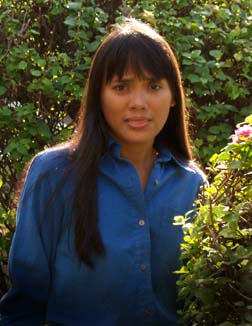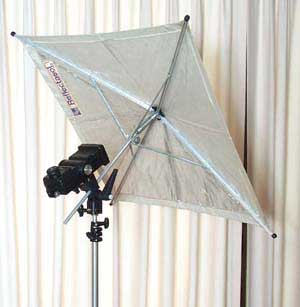Part Two A - Lighting
by Chuck Gardner
 Back light: Back lighting occurs when
the key light is behind the subject. It creates a halo-like
effect which helps to separate a dark subject from the dark
background, and increases the illusion of depth in the
photograph. This lighting angle is typically used outdoors
with an on-camera flash providing fill resulting in very flat
lighting on the subject's face. Back light: Back lighting occurs when
the key light is behind the subject. It creates a halo-like
effect which helps to separate a dark subject from the dark
background, and increases the illusion of depth in the
photograph. This lighting angle is typically used outdoors
with an on-camera flash providing fill resulting in very flat
lighting on the subject's face.
In a studio setting a small back light called a "hair light" is often aimed at the head and shoulders from the rear to provide separation between the subject's dark clothing and hair and a dark background. One or more lights may also be placed behind the subject facing away from the camera to illuminate the background. Butterfly lighting: (Corrected 10/22/02) Butterfly lighting uses a single light near the camera position, typically softened by umbrellas or light boxes, raised high above the subject. It produces soft shadows under the nose and cheekbones creating an illusion of depth. The name " Butterfly " describes the shape of the shadow produced under the nose of a full-face subject when this type of lighting is used. It is commonly used in fashion and catalog photography because it offers good lighting from a variety of angles and avoids harsh shadows which would obscure clothing detail. It works best for women with symmetrical faces and well defined cheekbones, kids, cats, and other difficult to pose critters. How many lights do you need?  It is not necessary to have a studio set-up with three or more expensive
strobe flash gun to take a well-lit, dramatic looking portrait. Just consider
the fact that the Sun is a single point source of light and it provides some
wonderful tonality and illusion of depth in nature. If you are just getting
started try using window light and a reflector for portraits. It is not necessary to have a studio set-up with three or more expensive
strobe flash gun to take a well-lit, dramatic looking portrait. Just consider
the fact that the Sun is a single point source of light and it provides some
wonderful tonality and illusion of depth in nature. If you are just getting
started try using window light and a reflector for portraits.
If you are using a digital camera which automatically compensates for white balance you can create an inexpensive home lighting set-up with some inexpensive incandescent or halogen work lamps. Getting a second "slave" flash unit with an electric eye that will trigger it via the on-camera flash and using on a light stand is a relatively inexpensive. If you put the second flash on a light stand with wheels or have an assistant aim it and use the simple f/stops = distance table outlined below it is easy to take great looking dual-flash candid pictures at even fast moving events like weddings. Using a second flash in this manner will add amazing depth and realism in your pictures and make them stand out from the competition. Goto Next Page > Goto < Previous Goto Class Outline Goto super.nova.org my home page. |